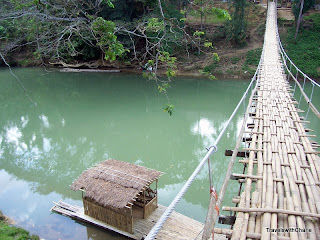Golden Gate Bridge (Image from Microsoft clip art)
The Golden Gate bridge turned 75 years old last week and the city of San Francisco celebrated this event in a big way with a Historic Watercraft Parade, dance, music and local bands performing at Marina Green and Crissy Field, and a host of other activities culminating in a spectacular display of fireworks.
I remember when I first saw the Golden Gate bridge decades ago and how disappointed I was then to see that the bridge wasn't really golden at all but a strange orangey color. In fact, it is painted in the International Orange hue. I didn't understand why they called it Golden Gate then but after many years, I learned to appreciate the bridge as it is.
Suspension Bridge, Bohol
While I'm on the topic of bridges, I found this photo of a suspension bridge over the Loboc River from our trip to Bohol a few years back. It was scary to try to cross this narrow hanging bridge. It swayed quite a bit when I tried to walk a few feet across and I couldn't seem to keep my balance. But surefooted locals had no qualms forging the bridge in no time.
Drawbridge over the Amstel River, Amsterdam
Methinks there's a little bit of affinity between a hanging bridge and a drawbridge. When the drawbridge is raised, it's hanging for a time till it's lowered back to position. It's always fascinating to watch a drawbridge being raised to allow watercraft to pass through. This happens quite a bit in Amsterdam with its myriad waterways.
Puente de la Mujer, Buenos Aires
The Puente de la Mujer or Woman's Bridge is a footbridge in the Puerto Madero district in Buenos Aires. It is designed by the famous Spanish architect, Santiago Calatrava, who has made similar, aesthetically captivating bridges around the world. The Puente de la Mujer is like a harp and as such, plays beautiful music to our senses.
Ponte Vecchio, Firenze
The Ponte Vecchio or Old Bridge has been here since the Roman Empire. It was destroyed by flood in 1333 and rebuilt in 1345. It can be crowded on the bridge most times but I enjoy window shopping here where beautiful, expensive jewelry call my name. Someday, I whisper back!
Speaking of old bridges, I must mention the Ponte dei Sospiri or Bridge of Sighs in Venice. It connects the Doge's Palace and the prison where, according to legend, convicts or enemies of state were led to their sad fate. Hence, sighs! There's also another legend that's more upbeat and romantic. It says that lovers will live happily ever after if they kiss inside a gondola gliding under the bridge at sunset. No less?
View from Charles Bridge, Prague
Two bridges worth mentioning are Charles Bridge in Prague and Pont Saint Bénezet in Avignon, France. Charles Bridge has the best views of Hradcany Castle and lots of statues of saints to protect you along the way. The Pont Saint Bénezet spans less than half the Rhone river after it was repeatedly destroyed by floods since its construction between 1171 and 1185. It's quite a sight to behold.
And one more bridge I love is Monet's Japanese bridge in his garden in Giverny. Someday I hope to replicate it in my own waterlogged garden. What a dream!
* * *
Images by Charie except as otherwise indicated





